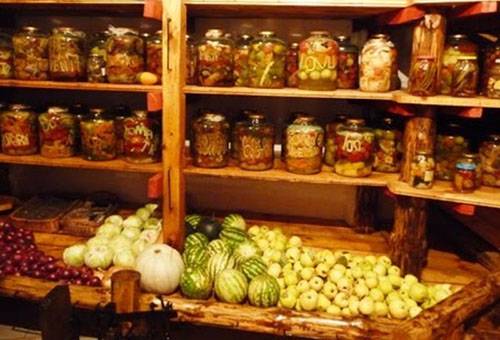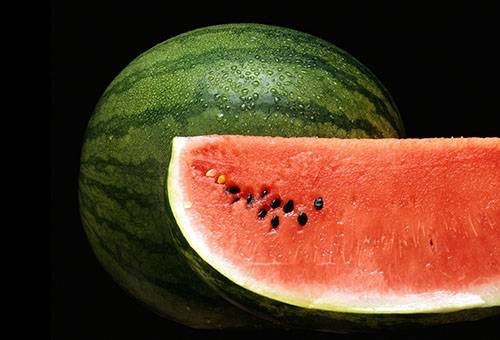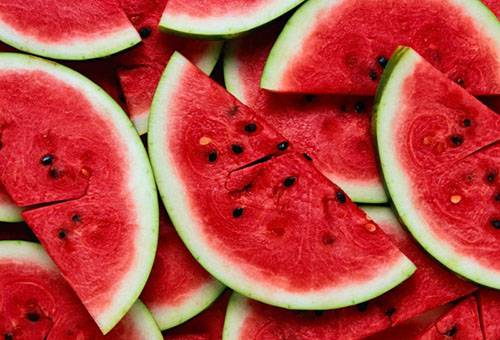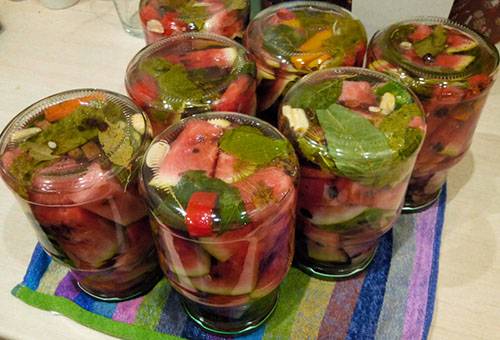How can you preserve a watermelon until the New Year?
Although tangerines are traditionally the symbol of the New Year, sometimes you want to see something more original on the festive table in winter. It may be a greeting from summer - a watermelon, but then the question arises of how to keep the watermelon safe and sound until the New Year with its pleasant taste, vitamins and microelements.
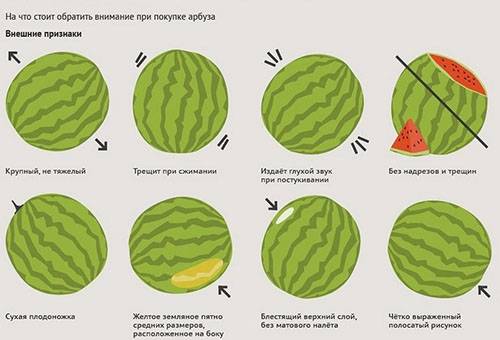
Choosing the perfect watermelon
What is important to do first is to choose the right fruit for storage.
- It is believed that watermelons retain all their beneficial properties at home for 3-4 months after picking, therefore, in order for them to survive the winter, the selected berry must be of late varieties, usually ripening in mid-to-late September. Moreover, they ripen on their own, which means they do not contain harmful additives that accelerate growth. The most common varieties for long-term storage are “Astrakhansky”, “Bykovsky”, “Volzhanin” and “Ikar”. All of them have juicy, sweet flesh and are quite resistant to disease.
- The berry must be intact - without cracks, scratches, dents, rot, etc., have clearly defined stripes on the peel and uniform coloring, indicating ripeness on all sides. It is better to choose medium-sized fruits - small ones may already be overripe by the time of harvest, but too large ones, on the contrary, may not yet have time to fully ripen.
- The selected variety should be characterized by thick skin and dense pulp.
- You should not make a purchase in supermarkets and large chain stores - usually unripe watermelons are delivered there, most likely stuffed with chemicals for safety during transportation and storage in display cases. It is better to purchase berries from trusted gardeners. And if you grew it yourself, then for subsequent long-term storage, the harvest should be harvested a few days earlier than usual. And, of course, do not overuse feeding of still growing watermelons with too much chemicals.
Storage rules
Watermelon must be stored correctly. Obviously, this should be done at a low temperature. Of course, you can put it in the refrigerator for several months, but then there won’t be much space left for other products. Therefore, it is worth choosing a freer place in which the following conditions will be met.
- The temperature is not higher than +5, +8 °C. Under no circumstances should you keep watermelons at room temperature for more than a couple of days - they begin to rot and ferment.
- Humidity within 60-80%. If it is too dry, the watermelon will quickly lose its liquid and look sluggish, and if it is damp, it will quickly rot.
- Good ventilation.
- Darkness.
A storage room, mezzanine or unheated but glazed balcony will fit these requirements (although in this case you will have to make sure that the temperature on it is not too low).
Advice
Experienced gardeners know how to preserve watermelon at home. The secret is that it needs to be well prepared for this - wash it thoroughly, trying not to damage the peel, wipe it and let it air dry. For maximum drying, you can cover it with straw overnight to absorb excess water.
How to store?
As for specific storage methods, there are several empirically tested options.
- Hanging. The watermelon is wrapped in natural fabric or old newspapers and hung in a canvas bag, net or string bag. The berries will be provided with ventilation and uniform temperature and humidity conditions.
- Covering with sand. The watermelon is placed in a wooden box and covered with sand, being careful not to compact it too much in order to allow air access. Sand can be replaced with dry grains, but it is important that they do not contain insect larvae or other pests.
- Straw. In this case, the watermelon can either be put in a box or simply placed on a shelf or on the floor, covered on all sides with clean straw. Instead of straw, ash (preferably hardwood), dry tow or thoroughly dried moss can also be used. But these products often harbor insects and rodents, so the storage area will have to be protected especially carefully.
- Clay. Due to its adsorbing and disinfecting properties, it will protect watermelons from dampness and fungus, and the resulting dense crust will protect it from external influences. The clay should be diluted in clean water, preferably in a non-metallic container, mixed thoroughly and applied to the surface of the fruit in a thick layer with your hands or a brush, then allowed to dry thoroughly and put the watermelons in a cool, dark place.
We store it wisely
The fruits cannot be stacked in several layers: the pressure will cause the skin, if it does not crack, to be a little wrinkled. It is better that the berries do not come into contact with each other at all, lying separately or with a thick layer of something soft between them. This way, not only will they not suppress each other, but they will also not suffer if one of them begins to rot and mold.It is not recommended to store watermelons with other fruits and vegetables, as they absorb foreign odors very easily. It is important that the watermelon does not lie on a hard surface, otherwise the peel will be at least somewhat wrinkled, which will affect the shelf life. You definitely need to lay something soft enough.
Berries hung in a net for the winter can be left completely alone, unless the place where they are stored gets colder or warmer too much - then they need to be removed to more suitable conditions. And fruits buried in sand or wrapped in dry grass must be inspected for safety and turned over on average once every 2-3 weeks. If it is noticed that one of them has begun to deteriorate, then there is no point in continuing to try to preserve the watermelon. If the spoiled part is small, you can cut it off and eat the rest right away, otherwise, immediately get rid of the rotten or moldy product.
It is important to understand that after harvesting and storage, watermelons practically do not ripen. And if a greenish, unripe fruit was originally purchased, then it will not become tastier or sweeter from lying for many months over the fall and winter.
How long can watermelon be stored?
If you buy a good watermelon and follow all the recommendations for its storage, it is quite capable of lasting not only until winter and the New Year, but also until spring. Moreover, using the same rules, you can save other popular melons and melons – melon and pumpkin – until the holidays.
Alternatives to long-term storage
If there are doubts that it will be possible to preserve a watermelon for so long, or there are no suitable conditions for storing it in the house, then this berry can always be placed on the New Year's table in canned form.Not only the delicious pulp itself will be used, but also the usually discarded peels. By boiling them with sugar, they make watermelon jam. The pulp is crushed and filtered, and the resulting juice is boiled, producing a thick, sweet syrup called watermelon honey. Both thick-skinned and thin-skinned varieties of watermelons, whole or cut into pieces, are pickled in brine, with cabbage, apples and even in sand. It turns out to be a very original snack, although out of habit some may not like it.
In winter, you can buy foreign watermelons in large stores. However, firstly, their price is tens of times higher than that of domestic products in the summer season, and secondly, they will be much less tasty. And the point here is not some bad varieties, but solely the fact that for long-term transportation the fruits are collected very unripe, and no matter how long they lie, they will not be able to ripen significantly.
